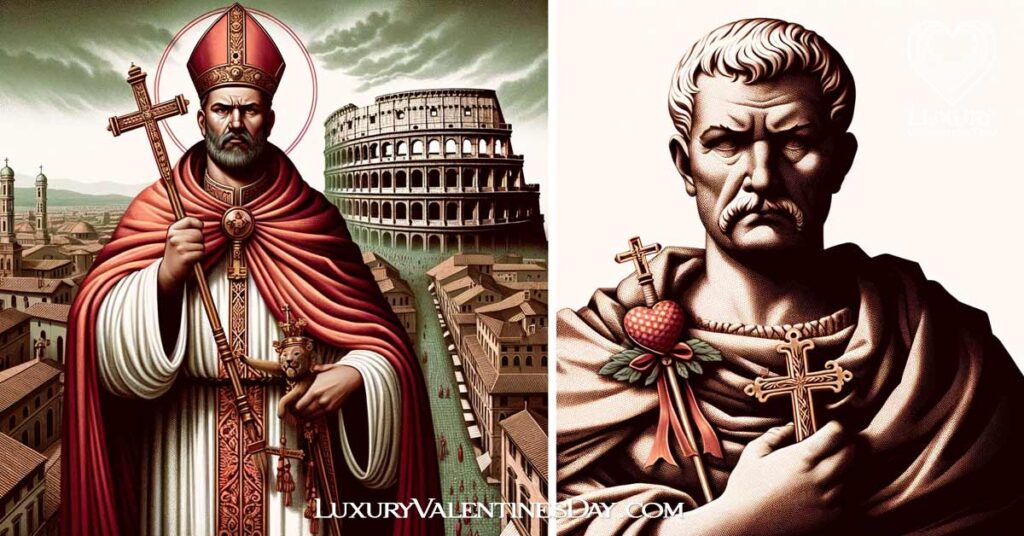
Table of Contents
ToggleThe Saint Valentine Story: The Heartbeat of Valentine’s Day
Welcome to the world of romance, where red hearts and sweet nothings reign supreme – it’s Valentine’s Day! But have you ever delved into the origin of Valentine’s Day? In this article, we’re on a journey to uncover the secrets of St. Valentine and his deep connection to the most romantic day of the year.
Let’s step back in time to ancient Rome, where the seeds of Valentine’s Day were sown in the rich soil of history. At the heart of it all was a fertility festival called Lupercalia. Celebrated annually from February 13th to 15th, this festivity was a raucous affair, drawing its origins from centuries of tradition.
The ancient Romans revered fertility, love, and the coming of spring. Lupercalia was a festival that called upon the gods to bless the land with fertility and ensure the well-being of the Roman people. Another intriguing custom of Lupercalia was the practice of drawing lots to pair young men and women together. Names were placed in a container, and the young men would draw names of young women who would be their partners during the festival, and sometimes even beyond. These pairings often led to marriages, and love would blossom amid the festivities.
Saint Valentine | |
Born | c. 226 Terni, Italia, Roman Empire |
| Died | c. 269 (aged 42–43) Rome, Roman Empire |
Venerated in | Catholic Church, Anglican Communion, Eastern Orthodoxy, Lutheranism |
| February 14 (Catholic, Anglican and Lutheran Churches); July 6 and July 30 (Eastern Orthodox) |
| Birds; roses; bishop with a crippled person or a child with epilepsy at his feet; bishop with a rooster nearby; bishop refusing to adore an idol; bishop being beheaded; priest bearing a sword; priest holding a sun; priest giving sight to a blind girl |
Patronage | Affianced couples, against fainting, beekeepers, happy marriages, love, mentally ill peoples, plague, epilepsy, Lesvos (for Catholics) |
Table content from Wikipedia
St. Valentine and the Christianization of Love: A Defiance of Emperor Claudius II

The transformation of Valentine’s Day from a pagan festival to a celebration of love was intimately tied to the rise of Christianity in the Roman Empire. But what led to this remarkable shift, and how did St. Valentine become entwined in the essence of love? This is the Saint Valentine story you’ve been waiting to hear.
Emperor Claudius II and the Ban on Marriages
Emperor Claudius II, also known as Claudius the Cruel, ruled during the 3rd century AD. His reign was marked by political turmoil and military challenges. One of the most notable decisions he made during his rule was to ban marriages for young men. This decree was rooted in his belief that single men made better soldiers. He thought that married soldiers might be more attached to their families and less dedicated to the Roman Empire.
Saint Valentine’s Act of Defiance
Amidst this backdrop of imperial decree, Saint Valentine, a Christian priest in Rome, chose a different path. He believed deeply in the sanctity of marriage and the enduring power of love. What did Saint Valentine do? Despite the ban on marriages, St. Valentine continued to perform Christian weddings in secret, defying the emperor’s orders. His actions were a testament to his unwavering commitment to love and the Christian faith.
Imprisonment and the Love Notes
Unfortunately, St. Valentine’s defiance did not go unnoticed. The authorities arrested him for his clandestine marriages and his unwavering dedication to love. During his time in prison, he crossed paths with the jailer’s daughter, and it was here that the legend of the love notes emerged. St. Valentine is said to have sent affectionate notes to this young woman, signing them “from your Valentine.” These notes became an enduring symbol of love and affection.
Who Was St. Valentine and What Was His Legacy?
The stories of Saint Valentine’s acts of defiance, secret marriages, and love notes from prison blend with the historical facts, creating a complex tapestry of myth and reality. Yet, one thing remains clear – St. Valentine’s unwavering commitment to love, even in the face of an emperor’s ban, laid the foundation for the celebration of love that we embrace today. If you’ve ever wondered, who was St. Valentine, this is your answer.
Who was the actual man behind the Saint Valentine?

St. Valentine’s name as we know it today is derived from the Latin “Valentinus,” which in turn is derived from the Latin word “valens” meaning “healthy or strong“, and this name is associated with several early Christian martyrs. The specific identity of the St. Valentine who is celebrated on February 14th is a subject of historical ambiguity, as there were multiple individuals named Valentine who were venerated as saints.
Nevertheless the Catholic Church recognized his sacrifice and declared him a saint. It was Pope Gelasius I who, in the year 496. A.D., officially established February 14th as the Feast Day of St. Valentine. This set the stage for the celebration of St. Valentine and, over time, the transformation of the feast day, into the more modern Valentine’s Day, which focuses on love and romance.
Pope Gelasius I is known for his efforts to Christianize pagan festivals, and it’s believed that he sought to replace the ancient Roman festival of Lupercalia, which was celebrated in mid-February, with a Christian holiday. By associating February 14th with the feast day of St. Valentine, he helped integrate the existing traditions of love and affection into the Christian calendar. This played a significant role in shaping the celebration of Valentine’s Day as we know it today.
Relics of Saint Valentine
Relics associated with one of the most well-known saints do exist, though their authenticity can be a subject of debate. Relics of Saint Valentine typically include bone fragments or other physical remains and even a vial of blood! Some of these relics are claimed to be located in various churches and shrines around the world, including the Basilica of Santa Maria in Cosmedin, Rome, Italy; St Anton’s Church in Madrid, Spain; and Whitefriar Street Church in Dublin, Ireland.
While the importance of relics in the Catholic and Christian Church is primarily rooted in faith and veneration, they also hold a place in Christian history and tradition. The veneration of relics is a deeply ingrained practice that connects believers to the saints, their spiritual heritage, and the history of Christianity.
Religion and Saint Valentine
The celebration of Saint Valentine’s Day varies across different Christian denominations and regions, which is why it is sometimes observed on different dates worldwide. In the Anglican Communion and the Lutheran Churches, Saint Valentine is commemorated on February 14. However, in the Eastern Orthodox Church, his recognition falls on July 6, and there is an additional observance of the feast of Hieromartyr Valentine, Bishop of Interamna, on July 30.
In 1969, the Catholic Church made changes to the General Roman Calendar, leading to the removal of St. Valentine’s name from the universal liturgical calendar. As a result, his celebration in the Catholic Church became subject to local calendars. However, the use of the pre-1970 liturgical calendar is also permitted under certain conditions, as outlined in the motu proprio Summorum Pontificum of 2007.
However, the Catholic Church continues to recognize Saint Valentine as a saint. He is listed as such in the Roman Martyrology, with February 14 designated as his feast day. Liturgical veneration of St. Valentine on February 14 is authorized in places where that day is not dedicated to another obligatory celebration. This flexibility allows for the celebration of Mass in honor of him on February 14 when it is not dedicated to another specific saint according to the Martyrology.
Despite these variations, one thing remains clear: St. Valentine’s unwavering commitment to love and the enduring power of affection have made him a timeless symbol of devotion. His legacy continues to inspire people around the world, transcending differences in faith, culture, and geography. St. Valentine, the man behind February 14, reminds us that love is a force that knows no bounds, connecting hearts across the ages.
Related Posts
- What to Wear on a First Date: Outfit Ideas for Every Occasion
- Hug Day – February 12: Embracing Affection in Luxury
- 101 Best Long-Distance Date Ideas For Valentine’s 2025: Your Ultimate Guide to Virtual Romance
- The Spiritual Tapestry of Valentine’s Day: From Sacred to Secular Luxury
- Date Ideas That Start with S: Sweet and Sensational Dates
- From Love Letters to Luxury: A Journey Through the History of Valentine’s Day Cards













